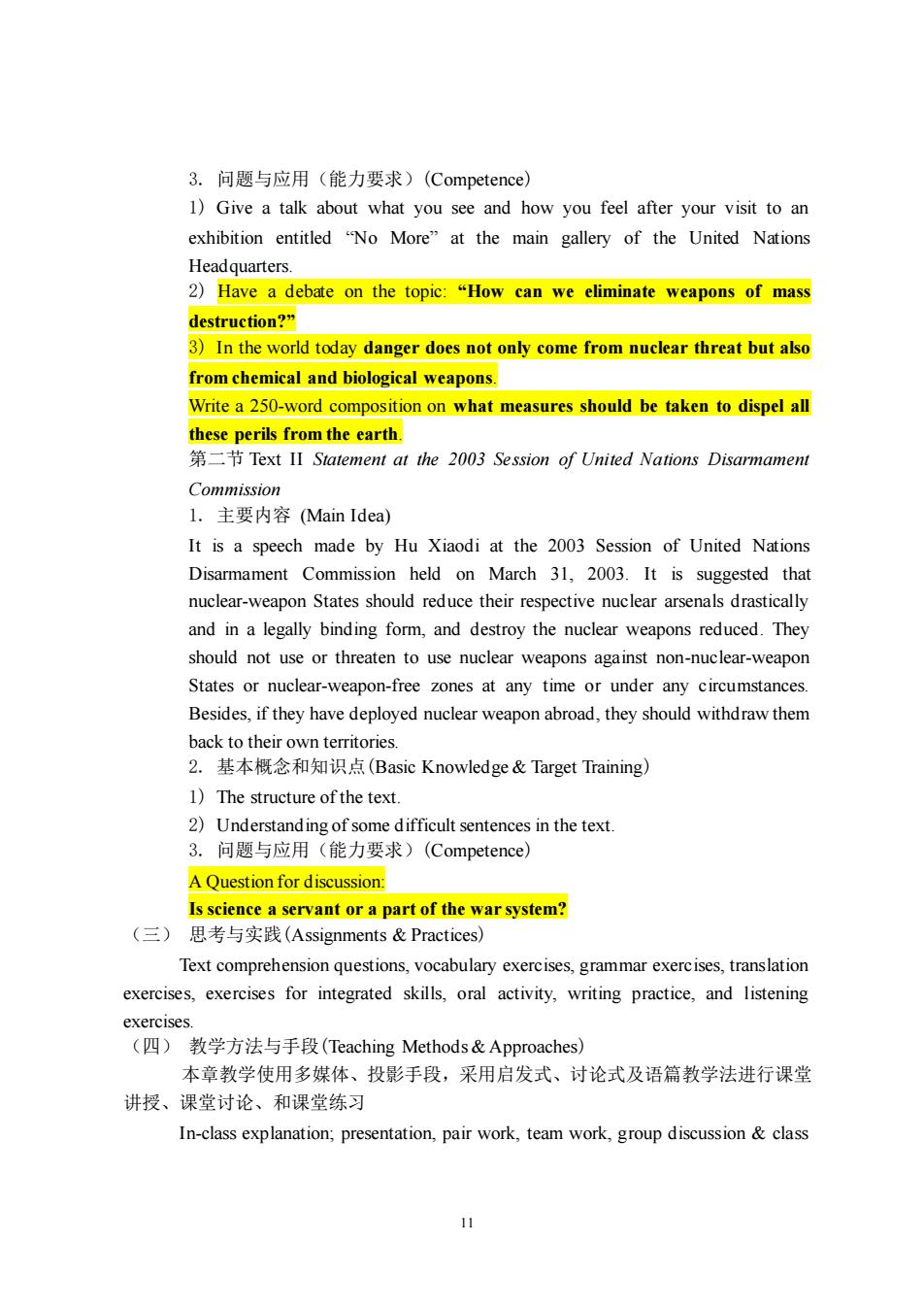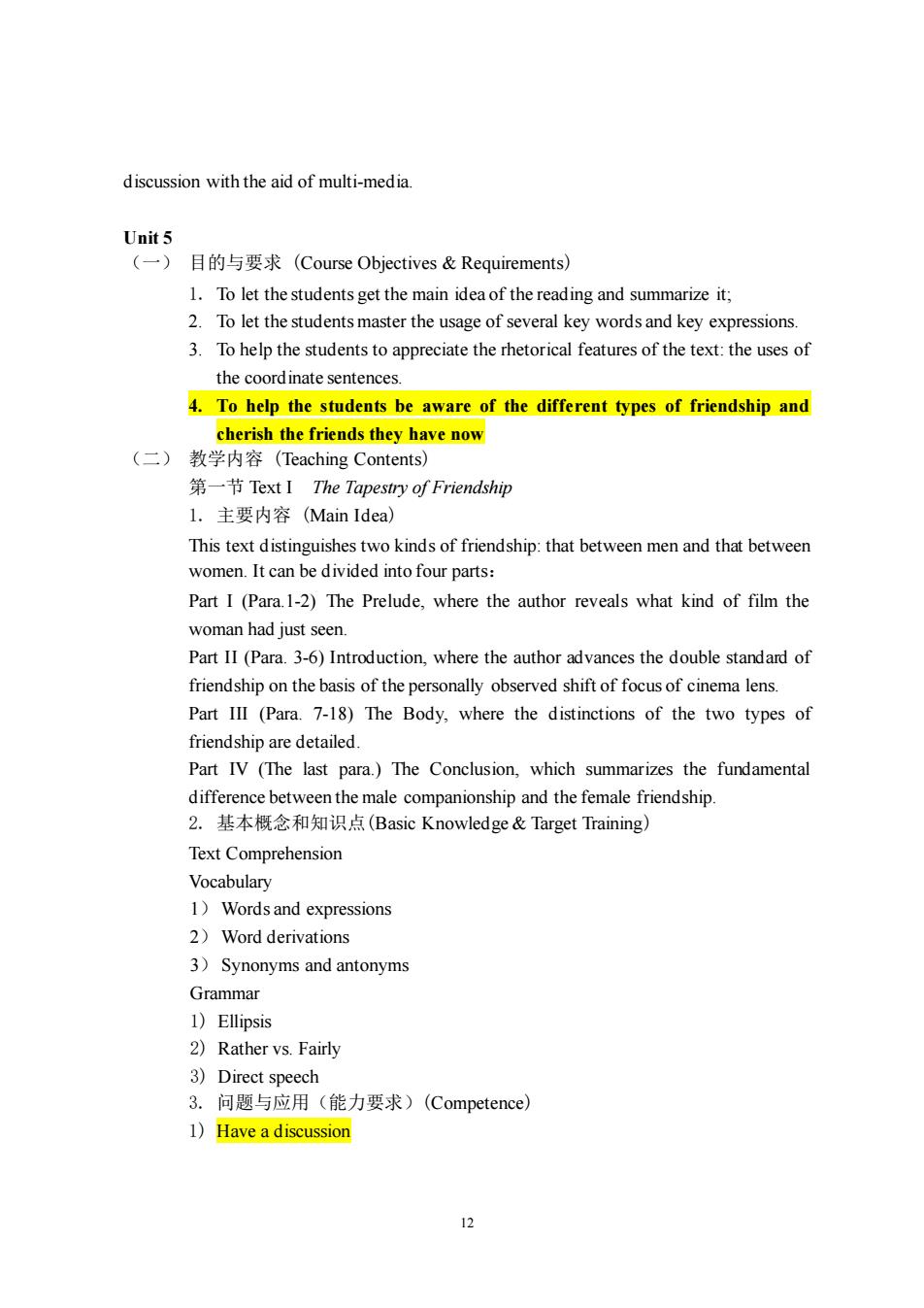
3.问题与应用(能力要求)(Competence). 1)Give a talk about what you see and how you feel after your visit to an exhibition entitled "No More"at the main gallery of the United Nations Headquarters 2)Have a debate on the topic:"How can we eliminate weapons of mass destruction?" 3)In the world today danger does not only come from nuclear threat but also from chemical and biological weapons. Write a 250-word composition on what measures should be taken to dispel all these perils from the earth. 第=节Text IⅡStatement at the2O03 Session of United Nations Disarmament Commission l.主要内容(Main Idea) It is a speech made by Hu Xiaodi at the 2003 Session of United Nations Disarmament Commission held on March 31,2003.It is suggested that nuclear-weapon States should reduce their respective nuclear arsenals drastically and in a legally binding form,and destroy the nuclear weapons reduced.They should not use or threaten to use nuclear weapons against non-nuclear-weapon States or nuclear-weapon-free zones at any time or under any circumstances. Besides,if they have deployed nuclear weapon abroad,they should withdraw them back to their own territories. 2.基本概念和知识点(Basic Knowledge&Target Training) 1)The structure ofthe text. 2)Understandingof some difficult sentences in the text. 3.问题与应用(能力要求) (Competence) A Question for discussion: Is science a servant or a part of the war system? (三)思考与实践(Assignments&Practices) Text comprehension questions,vocabulary exercises,grammar exercises,translation exercises,exercises for integrated skills,oral activity,writing practice,and listening exercises. (四)教学方法与手段(Teaching Methods&Approaches) 本章教学使用多媒体、投影手段,采用启发式、讨论式及语篇教学法进行课堂 讲授、课堂讨论、和课堂练习 In-class explanation;presentation,pair work,team work,group discussion&class 11
11 3. 问题与应用(能力要求)(Competence) 1) Give a talk about what you see and how you feel after your visit to an exhibition entitled “No More” at the main gallery of the United Nations Headquarters. 2) Have a debate on the topic: “How can we eliminate weapons of mass destruction?” 3) In the world today danger does not only come from nuclear threat but also from chemical and biological weapons. Write a 250-word composition on what measures should be taken to dispel all these perils from the earth. 第二节 Text II Statement at the 2003 Session of United Nations Disarmament Commission 1. 主要内容 (Main Idea) It is a speech made by Hu Xiaodi at the 2003 Session of United Nations Disarmament Commission held on March 31, 2003. It is suggested that nuclear-weapon States should reduce their respective nuclear arsenals drastically and in a legally binding form, and destroy the nuclear weapons reduced. They should not use or threaten to use nuclear weapons against non-nuclear-weapon States or nuclear-weapon-free zones at any time or under any circumstances. Besides, if they have deployed nuclear weapon abroad, they should withdraw them back to their own territories. 2. 基本概念和知识点(Basic Knowledge & Target Training) 1) The structure of the text. 2) Understanding of some difficult sentences in the text. 3. 问题与应用(能力要求)(Competence) A Question for discussion: Is science a servant or a part of the war system? (三) 思考与实践(Assignments & Practices) Text comprehension questions, vocabulary exercises, grammar exercises, translation exercises, exercises for integrated skills, oral activity, writing practice, and listening exercises. (四) 教学方法与手段(Teaching Methods & Approaches) 本章教学使用多媒体、投影手段,采用启发式、讨论式及语篇教学法进行课堂 讲授、课堂讨论、和课堂练习 In-class explanation; presentation, pair work, team work, group discussion & class

discussion with the aid of multi-media (一)目的与要求(Course Objectives&Requirements) 1.To let the students get the main idea of the reading and summarize it: 2.To let the students master the usage of several key words and key expressions. 3.To help the students to appreciate the rhetorical features of the text:the uses of the coord inate sentences. 4.To help the students be aware of the different types of friendship and cherish the friends they have now (二)教学内容(Teaching Contents) 第一节Text I The Tapestry of Friendship L.主要内容(Main Idea)) This text distinguishes two kinds of friendship:that between men and that between women.It can be divided into four parts Part I (Para.1-2)The Prelude.where the author reveals what kind of film the woman had just seen. Part II (Para.3-6)Introduction,where the author advances the double standard of friendship on the basis of the personally observed shift of focus of cinema lens. Part Ill (Para.7-18)The Body,where the distinctions of the two types of friendship are detailed. Part IV (The last para.)The Conclusion,which summarizes the fundamental difference between the male companionship and the female friendship. 2.基本概念和知识点(Basic Knowledge&Target Training) Text Comprehension Vocabulary 1)Wordsand expressions 2)Word derivations 3)Synonyms and antonyms Grammar 1)Ellipsis 2)Rather vs.Fairly 3)Direct speech 3.问题与应用(能力要求)(Competence)) 1)Have a discussion
12 discussion with the aid of multi-media. Unit 5 (一) 目的与要求 (Course Objectives & Requirements) 1. To let the students get the main idea of the reading and summarize it; 2. To let the students master the usage of several key words and key expressions. 3. To help the students to appreciate the rhetorical features of the text: the uses of the coordinate sentences. 4. To help the students be aware of the different types of friendship and cherish the friends they have now (二) 教学内容 (Teaching Contents) 第一节 Text I The Tapestry of Friendship 1. 主要内容 (Main Idea) This text distinguishes two kinds of friendship: that between men and that between women. It can be divided into four parts: Part I (Para.1-2) The Prelude, where the author reveals what kind of film the woman had just seen. Part II (Para. 3-6) Introduction, where the author advances the double standard of friendship on the basis of the personally observed shift of focus of cinema lens. Part III (Para. 7-18) The Body, where the distinctions of the two types of friendship are detailed. Part IV (The last para.) The Conclusion, which summarizes the fundamental difference between the male companionship and the female friendship. 2. 基本概念和知识点(Basic Knowledge & Target Training) Text Comprehension Vocabulary 1) Words and expressions 2) Word derivations 3) Synonyms and antonyms Grammar 1) Ellipsis 2) Rather vs. Fairly 3) Direct speech 3. 问题与应用(能力要求)(Competence) 1) Have a discussion